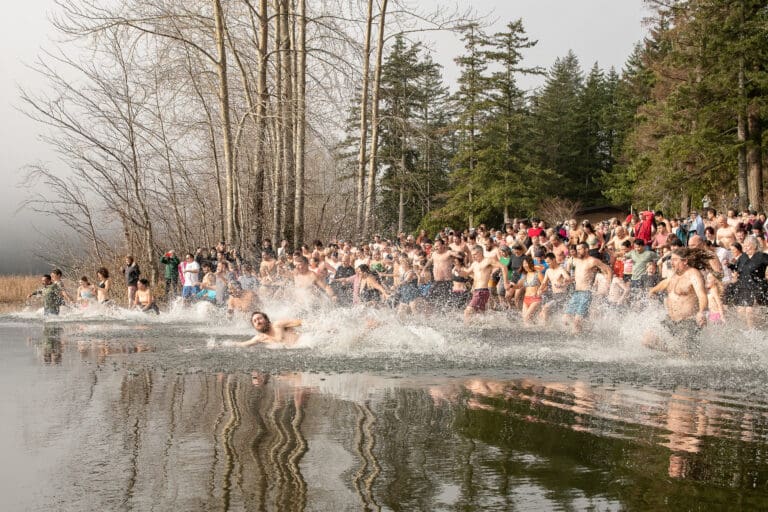Ferndale’s Jim Gizzi fell in love with the Winchester Mountain Lookout because of the breathtaking views that led Backpacker Magazine to name the trail the best day hike in America in 2017.
Yet, the inspiring vistas sometimes were offset by damage to the 14-by-14-foot fire lookout, leading Gizzi to become its caretaker in 2020.
Since then, he has organized volunteer crews for summer repair projects, including recently rebuilding the lookout’s west wall.
“It’s a special place, but people are hurting it,” said Gizzi, 65. “Winchester is close enough so people can get there and have an appreciation for the outdoors. But it is paying a price.”
The price was too heavy for David Inscho of Bellingham. The experienced backpacker maintained Winchester by himself for 15 years before handing it over to Gizzi.
“The final straw was showing up and finding the storm door and interior door broken into,” said Inscho, who takes care of Lookout Mountain in North Cascades National Park.

Gizzi and Inscho are affiliated with the Mount Baker Club of Bellingham, a group of outdoors-loving folks committed to preserving local lookouts and organizing recreational activities. The century-old club that created the precursor to the Ski to Sea race got a special federal permit in 1982 to oversee Winchester. Club members restored the dilapidated cabin two years later and have since preserved it for the public.
Groups like the Mount Baker Club have kept some of Washington’s 93 historic fire lookouts from decaying by volunteering to do upkeep.
“They are rare and special places to be,” Inscho said. “I’m trying to ensure as best as possible that others get that opportunity I stumbled into.”
Washington once had 686 lookouts
Washington once had 686 lookouts, according to Ray Kresek of the Fire Lookout Museum of Spokane. Officials erected the towers in response to the devastating fires in 1910 that burned 3 million acres of unlogged forests in Idaho, Montana and Washington.

Only about 25 spotters staff lookouts in the state nowadays as land managers rely more on aerial surveillance and other technological advances than the solitary figure scanning the horizon from a remote tower in the Cascades.
The U.S. Forest Service began staffing 6,520-foot Winchester Mountain in 1935 above the mining operations near Twin Lakes.
Like many lookouts, the building fell into disrepair from weather and vandalism after USFS abandoned it 36 years later.
Local lookouts at Church Mountain, Dock Butte, Dillard Point, Anderson Butte, Sauk Mountain and Excelsior Point have been removed, burned or were left to deteriorate.
Winchester is one of two structures left in the Mount Baker Highway corridor. The other is Copper Ridge, a bun-busting 20-mile round-trip hike over Hannegan Pass.
By contrast, Winchester is only 1.8 miles above Twin Lakes, which is accessible on a potholed dirt road. The easy access and publicity surrounding the hike have exacerbated problems by encouraging droves of Instagramers to capture up-close views of the Border Peaks and the Picketts Range. The lookout also has become a destination for weddings.
“It doesn’t take long to see people aren’t packing in and packing out,” Gizzi said. “It’s getting a little messy up there.”
The problem isn’t new. Inscho called himself a “lookout janitor” when maintaining Winchester, which was added to the National Historic Lookout Register in 1994.
The Mount Baker Club administrators had to close the ground house in the winter because of the extensive damage caused by careless overnight visitors. The cabin remains open from June to November on a first-come, first-served basis except when Gizzi’s crew is at work.
Repair work in July
In late July, as many as 18 club volunteers began repairing the wood-frame cabin built according to standard Forest Service Lookout House plans.
Gizzi worked with local hardware stores to get discounted rates on building materials. He estimated the project cost less than $1,000. The volunteers rely on donations, which can be made through the club website at https://mountbakerclubsite.wordpress.com.

While the hike to the lookout is less than 2 miles, the route ascends 1,300 feet with a sheer, rocky section to navigate.
Gizzi’s crew had to carry material and tools to the top. The haul included 30 boards and almost 15 pounds of fasteners, nails and bolts.
Day hikers not affiliated with the club helped lug supplies up the trail — and descended with scraps and other items, Gizzi said.

Workers constructed a new wall and then painted three of the cabin’s walls and the door. Club member Mike Reeve rebuilt a bunk/bench inside the cabin. He also fixed some shutters that had been closed for at least four years.
The crew worked through a persistent summer storm on a day Gizzi said, “We froze our butts off.”
The elements were but one obstacle. Workers can’t afford to make mistakes because the remote location means they carry only essential equipment and materials to the summit.
“You cut a piece of wood once, and it has to be right,” Inscho said. “There usually is no backup stuff.”
The workers completed this year’s task on Aug. 2. But the lookout needs continuous care. Future projects include rebuilding a door frame, fixing more shutters and repairing interior paneling.
“None of us are finished carpenters,” Gizzi said. “We’re all just guys who play around in the garage.”
Elliott Almond's outdoor column appears monthly. Email: elliottalmond4@gmail.com.




